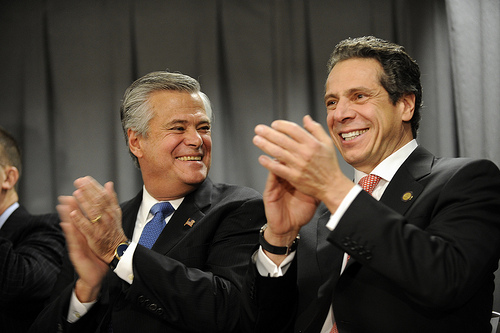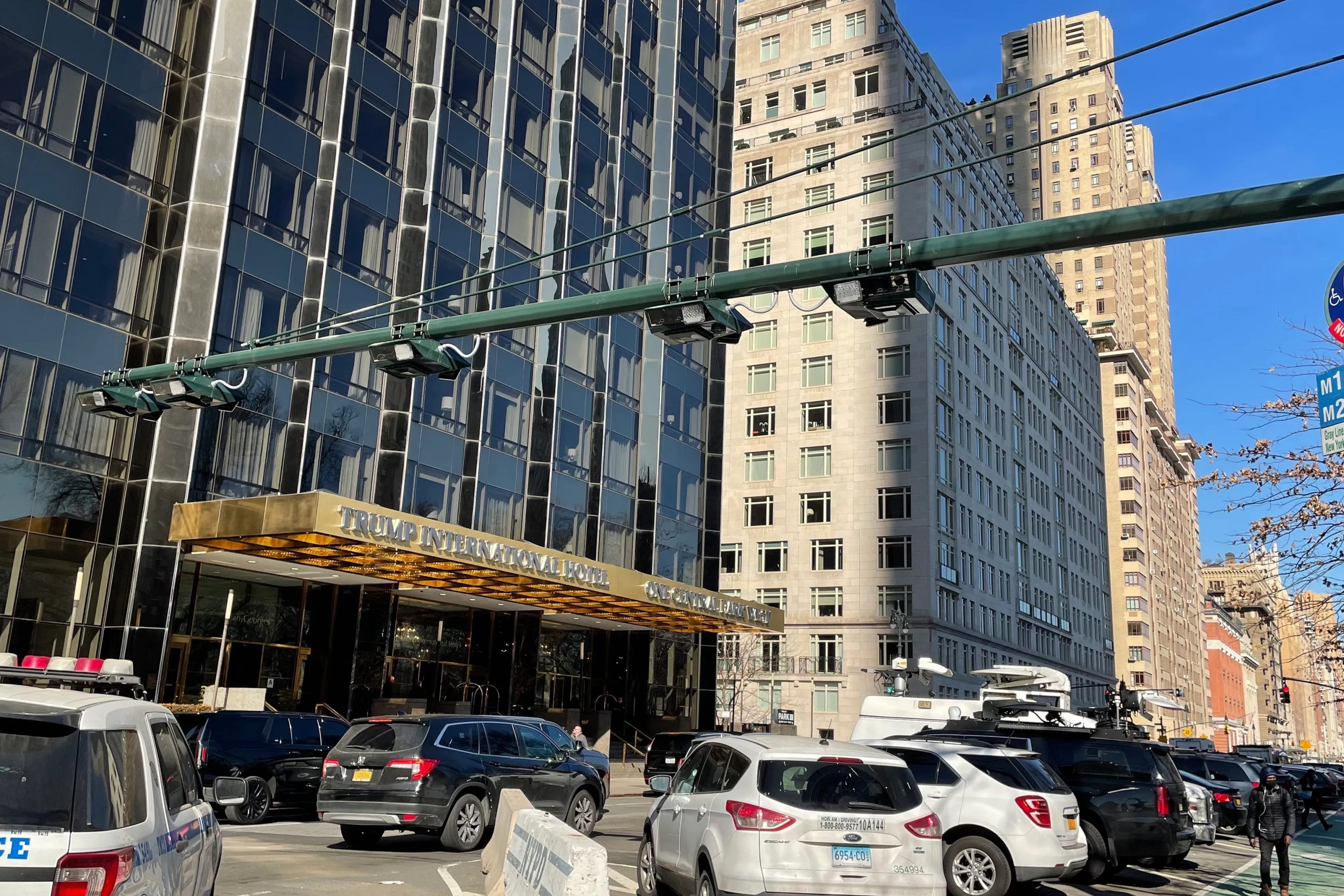
Looking back on 2011, there was a lot more bad news for New York City transit riders than good news. The Straphangers Campaign released its annual list of the ten best and worst events for subway and bus riders, and topping the "worst of" list are three separate ways that Governor Andrew Cuomo has attacked transit funding.
The news for transit riders wasn't all bad. Straphangers put the one-year respite from fare hikes at the top of their list (a brief reprieve -- the next one is scheduled for 2012). Other highlights include the launch of Select Bus Service on 34th Street, the launch of real-time bus tracking along some routes, and the reopening of the Cortlandt Street R station.
But those improvements and small kindnesses like the launch of the MTA's 511 phone number or its Weekender site design can't hold a candle to Cuomo's $100 million raid on the MTA's dedicated funding, his $320 million cut to the dedicated MTA payroll tax, or his nonchalant willingness to put three years of the MTA's capital plan on a giant credit card, which transit riders will be paying off for decades to come. As Straphangers noted, trains and buses are being left in service long after they should have been sent into retirement and breakdowns are increasing.
Here are Straphangers' two top ten lists in full:
Among the top ten worst New York City transit events in 2011 were:1. The State swept a net $100 million from dedicated transit operating funds. For the second year in a row, State government diverted money from accounts created to fund mass transit. The cuts add pressure to hike fares and cut service. Legislation to make it harder to raid dedicated transit funds passed both houses of the State legislature, but then was watered down.
2. The NY State Legislature voted exemptions to the MTA payroll tax at an unknown cost to its riders. As The New York Times editorialized: “Although the Albany leaders say that the state will make up any lost revenue, they have not determined a secure source of financing. Mr. Cuomo needs to make certain that the already cash-starved transportation authority doesn’t suffer. The last thing New York needs is to downgrade the system that gets so many people to and from their jobs.”
3. MTA proposed to take on $7 billion of debt for capital projects. With little hope of new funds, the MTA is proposing more borrowing to pay for its key rebuilding program. The result: half a billion in added interest payments a year, fueling pressure for higher fares to pay it back.
4. Aged trains on C line will now remain in service through at least 2017. They will be 53 years old, well past the tenure envisioned upon their gleaming debut during the Johnson Administration in 1964. The reason: shortfalls in capital revenues.
5. MTA over budget and behind schedule on Second Avenue Subway and East Side Access, say federal officials. The MTA says that ESA and Second Avenue will be done by September 2016 and December 2016, respectively, while the Federal Transit Administration puts their opening dates at April 2018 and February 2018. The feds say that ESA costs could go from $7.3 billion to $8.1 billion, Second Ave from $4.4 to $4.8 billion. The 7 line extension – paid for in large part by New York City – is reported 11 months ahead of schedule and may open in 2013.
6. Breakdowns increased and ridership decreased on NYC Transit buses. The breakdown rate has worsened more than 11% and total ridership is 3%, as of September 2011. Reason given: an aging bus fleet and a December 2010 fare hike. The percent of city buses that were 12 years or older more than doubled in the past year.
7. Hurricane Irene. It could have been much worse. In stark contrast to the blizzard of late 2010, the City and MTA performed well here. But many New Yorkers experienced what the loss of transit service meant to the city that never sleeps.
8. Garbage can-less subway stations. As part of a larger initiative to address subway garbage disposal problems, a pilot to remove garbage cans from two stations got a poor response from the public. The idea, wrote a columnist, “would seem to rank with fourth marriages…”
9. Passenger assaults on bus drivers and subway workers are up, 20% and 16% respectively, from January to October 2011. Bus drivers were spat on by riders 145 times during the same period. Are transit officials doing enough to protect their employees? The recent shooting on the Q111 also shows the vulnerability of riders to fatal violence.10. A tax-free transit benefit may shrink in half next year. The program – which exempts up to $230 of wages used for transit from most taxes – was increased in 2009. Right now the parking benefit is slated to go up to $240, while the transit benefit will fall to $125 unless Congress acts.
Among the top ten best New York City transit events in 2011 were:1. There was no subway, bus and commuter fare hike after three years-in-a-row of increases. The fare went up in 2008, 2009 and 2010 – but not in 2011. That was good news for cash-strapped riders in a harsh economy. But the MTA already says it needs a higher fare by the end of 2012.
2. Faster bus service arrived on the M34. This year, M34 passengers got to pay their fares before boarding, speeding up service on this notoriously slow route – if there’s good rider education on the new fare system. Coming in 2012: reconfigured bus stops to eliminate buses going in and out of traffic and increase sidewalk space.
3. Some of the service cuts from 2010 were restored in 2011. Weekend M50 bus service in midtown was re-instituted, as was the X36/38 express bus from Bay Ridge to Manhattan. Kudos to local officials like State Senator Marty Golden and Councilman Vincent Gentile. Massive cuts remain, but these restorations are worth celebrating.
4. MTA launched Weekender site. When you go to mta.info on Friday afternoons through Sunday evening, it becomes the Weekender, with easy-to-understand maps describing what most weekend visitors want to know: how will my commute be affected by transit construction and repair projects
5. Riders can now track the location of some bus routes by cell phone. “Bus Time” – which allows riders to get information on the location on buses on their cell phones – started on the B63 in February. By year’s end, it comes to all Staten Island bus routes. It’s convenient and encourages people to use buses.
6. In the shadow of the World Trade Center, the southbound Cortland Street station on the R re-opened. There was a grim time after 9/11 that a plywood, handwritten sign on the Cortlandt station warned train operators, ‘DO NOT STOP HERE.”
7. MTA adopted the 511 number for one-stop telephone help. Coupled with mta.info, this has the potential of providing better customer assistance at lower cost. But it still needs to be streamlined.
8. $1 fee on purchase of a MetroCard postponed. Supporters say it would reduce litter. Opponents see it as a fare hike and it’s not popular. The agency will hold off until 2013. The real solution: moving to smart cards.
9. A pilot brings cell phone service to six underground subway stations. Not everyone will agree that his is a good step. In a recent Straphangers Campaign opinion poll, riders voted 54% to 43% that this was a good idea. It’s important to note that riders for years have used cell phones at hundreds of stations above ground. Also, cell phones still won’t work in tunnels between stations.
10. More countdown clocks appear around the subways. New York City Transit set as a goal to install these highly popular displays at 153 stations on the number 1 through six lines by December 2011. Another 24 are on the L and a simpler version is at 32 stations on lettered lines.





